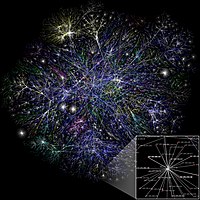
Photo from wikipedia
High-quality remote sensing images (RSIs) not only provide opportunities for deep-learning-based image interpretation but also challenge satellite edge devices for storage, processing, and downlinking to the ground server. Satellite on-orbit… Click to show full abstract
High-quality remote sensing images (RSIs) not only provide opportunities for deep-learning-based image interpretation but also challenge satellite edge devices for storage, processing, and downlinking to the ground server. Satellite on-orbit object recognition is an effective measure to solve this challenge. However, there is an insurmountable gap between the extremely limited computing and storage resources of satellites and the demand for those of deep learning. To solve this problem, a fast and lightweight intelligent satellite on-orbit computing network (SOCNet) is proposed. First, the overall network architecture based on the idea of flat multibranch feature extraction is proposed to accelerate model inference and reduce the network depth. Second, we propose the idea of exchanging a larger receptive field for network depth and combine the idea of depthwise separable convolution to further reduce the amount of parameters. We design a feature extraction method of coupled fine–coarse-grained for efficient feature extraction. Finally, global average pooling is used for feature fusion to further reduce the network parameters’ amount and computational complexity. We have performed multiple sets of ablation experiments and some state-of-the-art comparison experiments on the server and carried out experimental verification on the NVIDIA Jetson TX2 mobile device to mimic the resource-constrained environment on the satellite. SOCNet with parameters of 0.21 MB, model size of 1.22 MB, and computation cost of 50.81 MB floating point operations (FLOPs) has achieved 99% comprehensive accuracy, 2.45-ms latency, and 408 images per second throughput on 30 types of aircraft datasets with 224 $\times224$ RSIs.
Journal Title: IEEE Transactions on Geoscience and Remote Sensing
Year Published: 2022
Link to full text (if available)
Share on Social Media: Sign Up to like & get
recommendations!